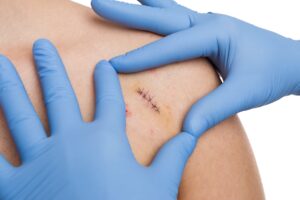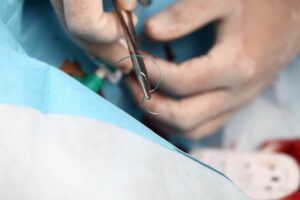When it comes to wound care, understanding the different methods of wound closure is crucial for proper healing and minimizing scarring. Stitches and sutures are commonly used techniques in medical practice to bring the edges of a wound together, allowing the body to mend itself. In this comprehensive guide, we share what you need to know about sutures and stitches, the healing process, and some important do’s and don’ts regarding wound care.
What is a Suture?
 A suture, in medical terms, refers to the stitching or sewing together of the edges of a wound or incision. Sutures are typically made of sterile materials like thread or wire and are used to close wounds, promote healing, and reduce the risk of infection. They act as a temporary bridge to hold the wound edges close together until the natural healing process occurs.
A suture, in medical terms, refers to the stitching or sewing together of the edges of a wound or incision. Sutures are typically made of sterile materials like thread or wire and are used to close wounds, promote healing, and reduce the risk of infection. They act as a temporary bridge to hold the wound edges close together until the natural healing process occurs.
Types of Sutures
There are several types of sutures available, each with its own characteristics and applications. Some of the most common types include:
- Absorbable Sutures: These sutures gradually break down and are absorbed by the body over time. They are often used for internal stitches, reducing the need for suture removal.
- Non-absorbable Sutures: These sutures are not absorbed by the body and require removal once the wound has sufficiently healed.
- Monofilament Sutures: These sutures consist of a single strand of material and are less prone to infection.
- Multifilament Sutures: These sutures are made of multiple strands twisted together. While they provide better knot security, they are more prone to infection and may cause a stronger tissue reaction.
- Barbed Sutures: These sutures have tiny barbs along their length, eliminating the need for knots. However, they are only used in specific circumstances, like closing subcutaneous tissue in plastic surgery.
Sutures vs. Stitches
“Sutures” and “stitches” are often used interchangeably, but they refer to slightly different concepts. Sutures are the actual threads or materials used to close wounds, while stitches refer to the act of sewing or suturing a wound. In essence, stitches are the technique, and sutures are the materials used for that technique.
Surgical Staples
Surgical staples are another common method of closing wounds or surgical incisions. They are generally made of stainless steel or titanium and resemble small, U-shaped clips. Surgical staples are often used in procedures involving the skin, gastrointestinal tract, and lungs. They offer several advantages, including speed and precision during closure.
When to Get Stitches
 Determining when stitches are needed for a wound is crucial for proper healing and minimizing scarring. Generally, stitches might be recommended if:
Determining when stitches are needed for a wound is crucial for proper healing and minimizing scarring. Generally, stitches might be recommended if:
- The wound is deep, with visible fat, muscle, or bone.
- The wound edges cannot be easily brought together.
- The wound is longer than half an inch or shows signs of gaping.
- The wound is located on the face or other areas where cosmetic concerns are important.
- The wound is caused by a dirty or contaminated object or injury.
- The bleeding from the wound does not stop with direct pressure.
- The wound is jagged or has irregular edges.
- The wound is in an area prone to frequent movement, which can impede natural healing.
How to Clean a Wound After Getting Stitches
Proper wound cleaning is essential to prevent infection and promote healing after stitches have been applied. Here are a few tips for keeping the wound clean:
- Wash Your Hands: Always start by thoroughly washing your hands with soap and water to prevent introducing harmful bacteria to the wound.
- Remove Dressing: Gently remove any dressing or bandage covering the wound as instructed by your wound specialist.
- Cleanse the Wound: Use a sterile saline solution to gently clean the wound. Avoid using hydrogen peroxide or alcohol, as these can be harsh on the tissue.
- Pat Dry: After cleaning, pat the area around the wound dry with a clean, sterile gauze pad. Avoid rubbing, as it can irritate the wound.
- Reapply Dressing: If recommended, apply a new sterile dressing and secure it in place.
- Follow Instructions: Follow any specific wound care instructions provided by your specialist. They may recommend applying an antibiotic ointment or other treatments.
The Healing Process
Understanding the stitching healing process can help you better care for your wound.
- Inflammation: In the initial stages, the wound may appear red, swollen, and tender. This is a normal part of the healing process and indicates that the body is sending white blood cells to fight infection and promote tissue repair.
- Tissue Repair: Over time, the body works to repair the damaged tissue. New collagen forms to bridge the wound, gradually closing it.
- Scar Formation: As the wound heals, it may develop a scar. Proper wound care, including keeping the wound clean and protected, can help minimize scarring.
- Complete Healing: Depending on the size and location of the wound, complete healing can take several weeks to months.
How Are Stitches Removed?
Stitch removal is a common procedure that should be performed at a wound care center or by a specialist. Here’s how stitches are typically removed:
- Preparation: The specialist will clean the area around the stitches with an antiseptic solution.
- Stitch Removal: Using small scissors or a scalpel, the stitches are carefully cut along the knot.
- Extraction: After cutting the stitches, each stitch is gently pulled out of the skin.
- Wound Inspection: The specialist will then examine the wound to ensure proper healing and may apply an adhesive strip or sterile dressing if needed.
Can I Remove My Own Stitches?
While it is possible to remove your own stitches under certain circumstances, it is generally not recommended. Wound care specialists are trained to perform this procedure safely and hygienically to minimize the risk of infection or complications.
Attempting to remove your own stitches may result in pain, injury, or improper removal, which can lead to infection or scarring.
Should I Cover a Wound After Stitches are Removed?
After stitches are removed, it’s important to keep the wound clean and protected. In most cases, a wound care specialist will advise you to keep the wound covered with a sterile bandage or dressing for a few days to protect the healing tissue. Make sure to follow your specialist’s instructions for proper wound care and dressing changes.
Wound Care Tips After Stitches Are Removed
After removal, proper wound care is still important to ensure the wound continues to heal well. Here are a few wound care tips to keep in mind:
- Keep It Clean: Continue to clean the wound as directed by your specialist. Use a gentle saline solution and pat it dry with a clean, sterile gauze pad.
- Protect the Wound: If instructed, keep the wound covered with a sterile dressing or bandage to prevent infection and protect the area.
- Avoid Excessive Moisture: Try to keep the wound dry. Avoid soaking it in water, such as in baths or swimming, until it has fully healed.
- Monitor for Signs of Infection: Keep a close watch on the wound for any signs of infection. If any of these symptoms occur, contact a wound care specialist.
- Minimize Sun Exposure: Avoid exposing the wound to excessive sun, as UV rays can slow down the healing process and lead to hyperpigmentation in the scar.
Conclusion
Understanding the various aspects of stitches, sutures, and surgical staples is essential for effective wound care and optimal healing. Remember to follow your wound specialist’s recommendations and be patient as your body works to heal itself. If you have any concerns about your wound or the healing process, don’t hesitate to book an appointment at West Coast Wound Center.
